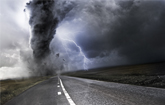Natural Disasters and College Campuses: A New Report Highlights Resilience and Readiness in U.S. Universities
HILLSBOROUGH, N.C., Nov. 12, 2024 /PRNewswire/ -- With climate change accelerating the frequency of extreme weather, universities across the United States are increasingly vulnerable to natural disasters. In a new report, College Consensus examines the impact of past natural disasters on major campuses nationwide, underscoring the urgent need for universities to adopt robust disaster preparedness plans.
The report, Campus Natural Disasters: Lessons in Resilience, explores the devastation caused by events such as the Great Earthquake of 1906 at Stanford University, Hurricane Katrina at Tulane University, and the Camp Fire of 2018 at California State University, Chico. Other disasters covered include:
- The 1937 Ohio River Flood and the University of Louisville
- The 1948 Vanport Flood and Portland State University
- The 1980 Mount St. Helens eruption and Washington State University
- The 2008 Iowa River Flood and the University of Iowa
- Hurricane Florence and the University of North Carolina at Wilmington in 2018
These cases reveal the profound, lasting impacts natural disasters have on university infrastructure, student well-being, and academic continuity. Additionally, the report highlights the efforts of institutions to rebuild and enhance resilience, setting critical examples for disaster preparedness across the education sector.
"Natural disasters have become an inevitable risk for universities, not just in high-risk regions but nationwide," states the report's author, Gabe Sealey-Morris. "Our goal is to raise awareness and encourage institutions to strengthen their preparedness and resilience, thereby protecting students, faculty, and valuable campus assets."
Key Findings and Lessons in Resilience
The report details numerous disasters, starting with Stanford University's resilience after the 1906 earthquake, which forced a temporary campus closure but saw students rally to support recovery efforts. Similarly, Tulane University, which endured over $650 million in damage during Hurricane Katrina, coordinated with hundreds of colleges nationwide to ensure students could continue their studies while the university rebuilt.
One of the report's central insights is the proactive role colleges have taken in post-disaster community support. In the wake of Hurricane Florence in 2018, the University of North Carolina at Wilmington established "Wings Up for Wilmington," an annual service day dedicated to aiding the local community. Likewise, California State University, Chico, actively engages in wildfire research and educational programs following the 2018 Camp Fire, which devastated much of Butte County.
In addition to financial and infrastructural challenges, the report emphasizes the impact on students, many of whom lack disaster-related insurance or a backup plan in case of evacuation. During Hurricane Katrina, for instance, Tulane's students were welcomed by other universities to continue their coursework. However, such arrangements highlight the need for improved policies ensuring minimal disruption to students' education in future crises.
Building a Culture of Preparedness in Higher Education
In response to these risks, universities are increasingly taking proactive steps. Institutions like Florida International University have integrated disaster resilience into their campus culture and academic programs. The university's Disaster Resilience Program fosters a coordinated disaster response and includes partnerships with local agencies to fortify hurricane-resistant structures and establish a cloud-based academic access platform. These initiatives not only address immediate safety but also demonstrate how preparedness can support academic continuity.
At the University of California, Berkeley, seismic retrofitting is part of a comprehensive emergency plan that includes education on preparedness for students and staff. As severe weather events escalate, these models exemplify ways other universities can prioritize disaster readiness.
Future Implications and Community Engagement
As natural disasters continue to pose risks, the report calls on educational institutions to focus on long-term resilience, from safe shelter provisions to mental health support. "Colleges play a dual role—protecting their own communities while serving as hubs for broader disaster relief efforts," adds Sealey-Morris.
For more information on disaster resilience in universities or to read the full report, visit College Consensus at https://www.collegeconsensus.com.
Media Contact:
Jeremy Alder
[email protected]
(919) 698-3709
Social Media:
Facebook - @collegeconsensus
Instagram - @collegeconsensus
Twitter - @CollegeConsens
SOURCE College Consensus

WANT YOUR COMPANY'S NEWS FEATURED ON PRNEWSWIRE.COM?
Newsrooms &
Influencers
Digital Media
Outlets
Journalists
Opted In





Share this article